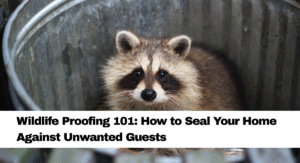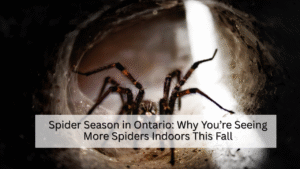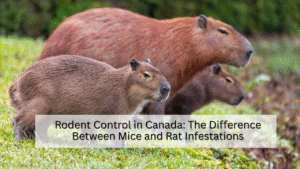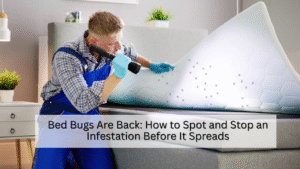It usually starts with a buzz. Then another. And before you know it, there’s a steady stream of wasps darting around your porch, roofline, or backyard shed.
You step outside and spot it, a round, papery nest tucked under the eaves or behind a light fixture.
Your first thought is probably, “Can I handle this myself?”
That’s a fair question, and the right answer depends on where the nest is, how big it’s gotten, and how safe you can be around it.
Let’s break down how to identify different wasp nests, what you can safely do on your own, and when it’s time to call in the professionals.
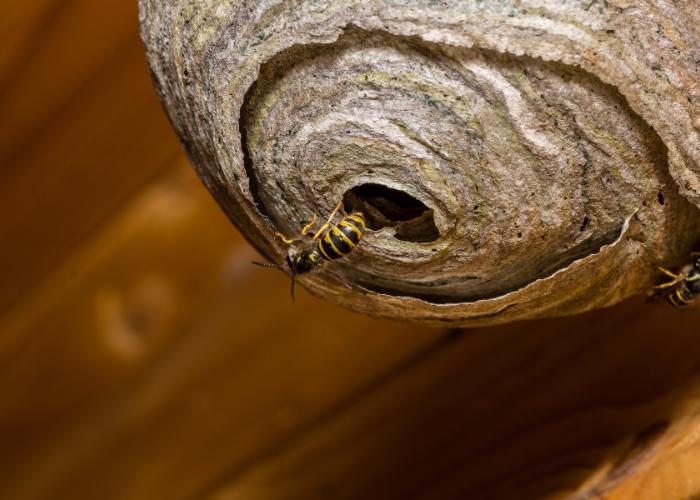
Understanding Wasps in Ontario
Ontario is home to several types of wasps, each with its own habits, aggressiveness, and nesting style.
Here are the main ones you’re likely dealing with:
1. Paper Wasps
Build umbrella-shaped, open comb nests under eaves, decks, and railings.
Usually not aggressive unless their nest is disturbed.
Small colonies of 20 to 50 wasps.
2. Yellowjackets
The ones most people fear, aggressive defenders of their nests.
Often nest underground, in wall voids, or inside attics.
Populations can reach thousands by late summer.
3. Hornets (Bald-Faced Hornets)
Larger and black-and-white in color.
Build big, enclosed paper nests that can hang from trees or buildings.
Protective and quick to sting if they sense movement near their nest.
All wasps are part of nature’s cleanup crew. They pollinate plants and eat other insects. But when they set up shop near your front door or play area, they quickly go from helpful to hazardous.
Why Wasps Build Nests Near Homes
Wasps aren’t out to bother you; they’re just looking for a safe, dry place to build and feed their colony.
Your home offers everything they need:
- Shelter: Eaves, vents, decks, and sheds protect nests from wind and rain.
- Food: Wasps feed on other insects, fruit, and leftover food or garbage.
- Water: Birdbaths, pet bowls, or dripping taps make perfect hydration stations.
They start building in spring, but by late summer, colonies are fully grown—and that’s when most people notice the problem.
Spotting a Wasp Nest Early
Catching a nest early makes all the difference. A small, golf ball-sized nest is easy to manage; a basketball-sized one is not.
Watch for:
- Wasps flying in and out of the same spot repeatedly.
- Buzzing sounds behind walls, vents, or deck boards.
- Small gray papery clumps under roof edges or eaves.
If you notice these signs in April or May, you have a great chance of removing the nest safely before it gets big.
By August, it’s usually best left to professionals.

When You Can Handle It Yourself (DIY)
You can safely handle a small wasp nest under certain conditions, but only if you take precautions and the nest is easily accessible.
Here’s when DIY is reasonable:
- The nest is smaller than a tennis ball.
- It’s located outdoors, away from entrances or high foot traffic.
- You’re not allergic to stings.
- You can reach it easily without climbing or stretching.
DIY Steps
- Wait until night. Wasps are less active in the dark and more likely to be inside the nest.
- Wear protective clothing. Cover all skin—gloves, goggles, and a hoodie if possible.
- Use a wasp spray designed for outdoor nests. Spray directly into the opening for several seconds from a safe distance.
- Leave the area immediately. Do not try to knock down the nest right away.
- Check again after 24 hours. If no activity remains, you can remove the nest using a stick or long pole and seal it in a plastic bag.
If you notice even one wasp still flying around, give it another day before removing.
When Not to DIY
Here’s when you should absolutely not try to remove a nest yourself:
- It’s inside walls, attics, or vents. Wasps can rebuild or spread through cavities, and sprays won’t reach the whole colony.
- It’s larger than a baseball. Large nests mean hundreds of wasps, and one wrong move can trigger a swarm.
- You can’t access it safely. Ladders and sprays are a bad combination, and a sting on a ladder can easily cause a fall.
- You’re allergic to wasp stings. Even one sting can be dangerous. Don’t risk it.
- There are repeated nests each year. That often means structural gaps or scent trails that keep attracting new queens.
In any of these cases, it’s better and safer to call a professional pest control service.
What Professionals Do Differently
At BugManagers, our technicians handle wasp removal across Ontario using safe, targeted methods that eliminate the entire colony, not just what you can see.
1. Inspection
We find the exact nest location and type, even if it’s hidden behind siding, under decking, or in roof cavities.
2. Safe Treatment
We use specialized insecticidal dusts and foams that reach deep into the nest.
These work fast and prevent wasps from rebuilding in the same spot.
3. Nest Removal and Clean-Up
Once the colony is gone, the nest is removed carefully and disposed of.
This also gets rid of pheromones that attract future wasps.
4. Prevention Tips
We help you identify what attracted them—like open garbage bins, fruit trees, or gaps under eaves—and recommend fixes.
Professional removal is quick, efficient, and prevents repeat infestations, something DIY rarely guarantees.
How to Keep Wasps Away in the First Place
Wasps return to familiar spots year after year. A few preventive steps can help make your home less attractive.
- Seal Entry Points
Caulk small cracks around eaves, vents, and window frames. Wasps love gaps where they can start building unnoticed. - Cover Garbage and Recycling Bins
Food waste, sugary drinks, and meat scraps attract worker wasps searching for protein and sugar. - Clean Up After Barbecues
Wipe tables and grills, and rinse cans before recycling. Even a small spill can bring wasps over within minutes. - Hang Decoy Nests
Wasps are territorial. A fake nest can trick them into thinking the area is already claimed. - Maintain Outdoor Areas
Trim back shrubs and trees near the house, and check decks and sheds regularly for early nest-building activity.
Small habits like these go a long way in keeping your home wasp-free.
Why You Shouldn’t Just “Wait It Out”
Some people think it’s okay to leave a nest alone since wasps die off in winter.
But here’s what really happens:
- The nest may become a home for new queens who hibernate nearby and return next spring.
- Leftover material and scent attract other insects or another colony next season.
- Old nests can cause structural issues if built inside walls or vents.
In short, waiting it out just sets the stage for next year’s problem.
What to Do If You’re Stung
Most wasp stings are painful but not dangerous.
Here’s how to handle one safely:
- Move away from the area immediately.
- Clean the sting with soap and water.
- Apply a cold compress for swelling.
- Take an antihistamine if needed for itching.
Seek medical help right away if you experience trouble breathing, dizziness, or swelling beyond the sting area, as these can be signs of an allergic reaction.
Final Thoughts
Wasps play an important role in the ecosystem, but that doesn’t mean you have to share your home with them.
If the nest is small and safe to reach, you might handle it on your own. But if it’s large, hidden, or aggressive, it’s best to let professionals take over.
At BugManagers, we provide safe, quick, and humane wasp removal services across Ontario.
Our team identifies the species, eliminates the colony, and prevents future nests so you can enjoy your yard again without the fear of stings or buzzing.
Remember: a few wasps today can turn into a colony tomorrow.
Take care of the problem early, and keep your summer spaces peaceful, clean, and sting-free.



